Wildlife photography in Kenya offers stunning opportunities to capture iconic species in breathtaking landscapes. Explore the best locations like Maasai Mara, Amboseli, and Tsavo. Discover the most photographed animals, including lions and elephants. Learn about ethical practices to protect wildlife while navigating challenges like unpredictable weather and difficult terrain.
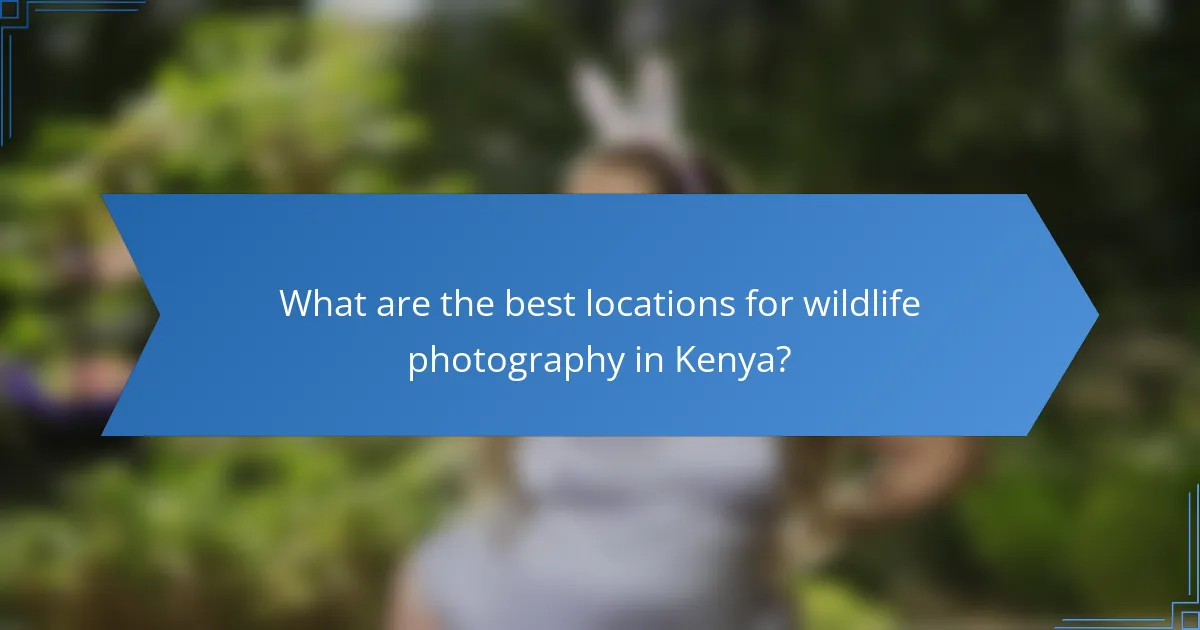
What are the best locations for wildlife photography in Kenya?
The best locations for wildlife photography in Kenya include Maasai Mara, Amboseli National Park, and Tsavo National Park. Maasai Mara is renowned for its diverse wildlife and the Great Migration. Amboseli offers stunning views of Mount Kilimanjaro alongside elephants. Tsavo is known for its unique red elephants and vast landscapes. Each location provides distinct opportunities for capturing iconic species and breathtaking scenery.
Which national parks offer the most diverse wildlife?
Kenya’s national parks offer some of the most diverse wildlife experiences globally. Notable locations include Maasai Mara National Reserve, known for the Great Migration, and Amboseli National Park, famous for its elephants and views of Mount Kilimanjaro. Tsavo National Park is vast and home to a range of species, including lions and rhinos. Lake Nakuru National Park is renowned for its flamingos and diverse birdlife. Each park provides unique opportunities for wildlife photography while emphasizing ethical practices to protect these habitats.
How do seasonal migrations affect photographic opportunities?
Seasonal migrations greatly enhance photographic opportunities in Kenya by attracting diverse wildlife. The Great Migration, for instance, draws millions of wildebeest and zebras to the Maasai Mara, creating dynamic scenes for photographers. Additionally, migratory birds flock to various regions, offering unique chances to capture rare species. Timing visits during these migrations can significantly increase the likelihood of stunning wildlife shots.
What are the hidden gems for wildlife photography in less-traveled areas?
Kenya offers several hidden gems for wildlife photography in less-traveled areas, such as the Losai National Park and the Kora National Park. These locations provide unique opportunities to capture diverse species and stunning landscapes, often without the crowds found in popular parks.
Losai National Park is known for its remote setting and rich wildlife, including elephants and rare antelope species. Kora National Park, located along the Tana River, is home to various birds and offers picturesque riverine scenery. Both parks emphasize ethical photography practices, encouraging minimal disturbance to wildlife.
Exploring these hidden gems can lead to exceptional photography experiences, showcasing the beauty of Kenya’s lesser-known ecosystems.
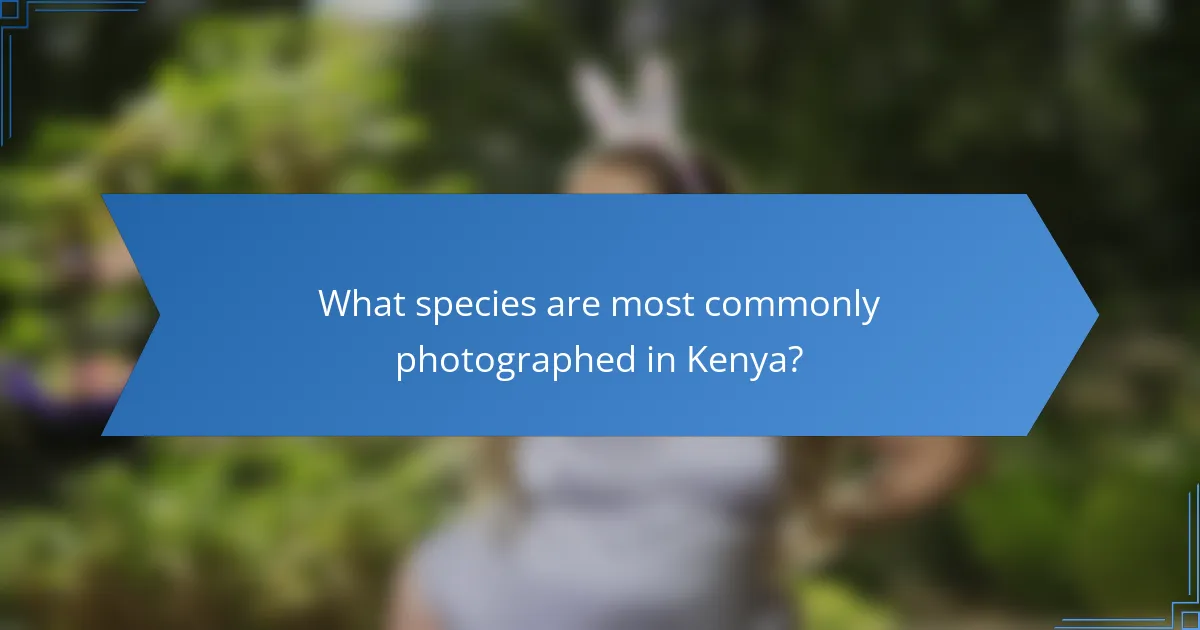
What species are most commonly photographed in Kenya?
The most commonly photographed species in Kenya include lions, elephants, cheetahs, giraffes, zebras, and rhinoceroses. These iconic animals attract photographers due to their unique behaviors and stunning appearances. The Maasai Mara and Amboseli National Parks are prime locations for capturing these species in their natural habitats.
Which big cats are iconic in Kenyan wildlife photography?
The iconic big cats in Kenyan wildlife photography include lions, leopards, and cheetahs. These species are renowned for their distinct behaviors and stunning appearances, making them popular subjects for photographers.
Lions are often photographed in prides, showcasing their social dynamics. Leopards, known for their elusive nature, provide unique opportunities for capturing stealth and grace. Cheetahs, with their incredible speed, offer thrilling action shots during hunts.
Photographers frequently encounter these big cats in renowned locations such as the Maasai Mara and Amboseli National Park. Ethical considerations, such as maintaining a safe distance and minimizing disturbance, are crucial for responsible wildlife photography.
What unique bird species can be captured in various habitats?
Kenya hosts unique bird species across diverse habitats. Notable examples include the African Fish Eagle in wetlands, the Great Blue Turaco in forests, and the Endemic Sharpe’s Longclaw in grasslands. Each species thrives in its specific environment, showcasing Kenya’s rich avian diversity.
How do the behaviors of different species influence photography techniques?
The behaviors of different species significantly influence photography techniques. Understanding animal movements and habits allows photographers to anticipate moments for compelling shots. For instance, observing a lion’s hunting patterns can guide the choice of camera settings and positioning. Additionally, the time of day when animals are most active, such as dawn or dusk, affects lighting conditions and composition. Ethical considerations, like maintaining a safe distance, also shape techniques to ensure minimal disturbance to wildlife. This knowledge enhances the overall quality and impact of wildlife photography in Kenya.
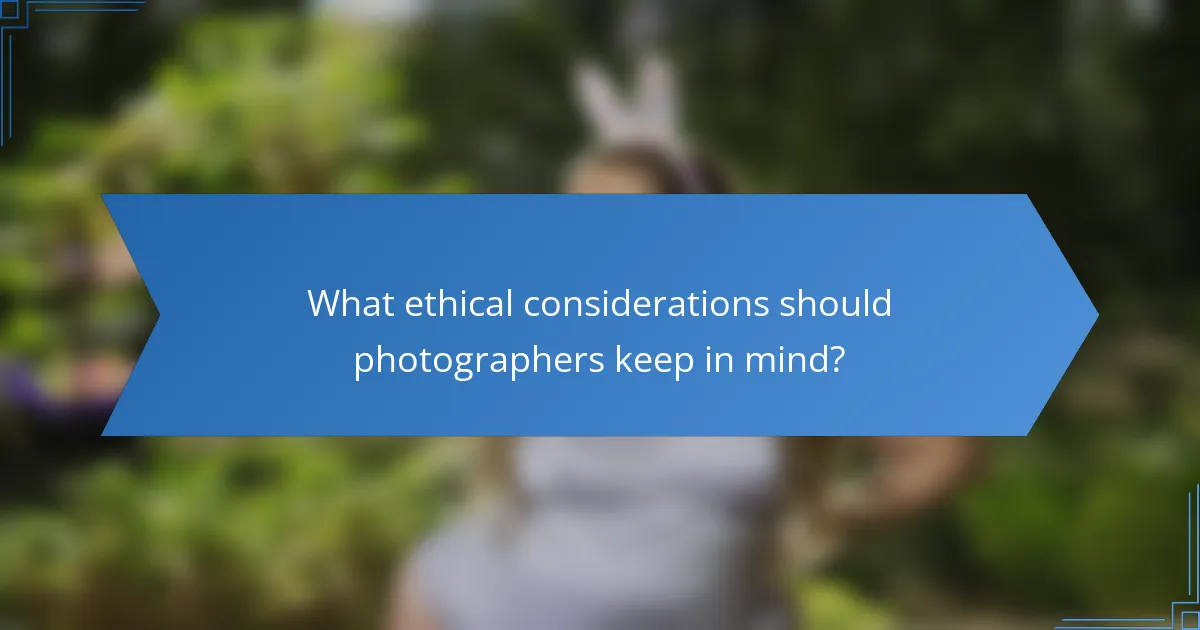
What ethical considerations should photographers keep in mind?
Photographers should prioritize ethical practices to protect wildlife and their habitats. Respecting animal behavior and avoiding disturbance is crucial.
1. Maintain a safe distance to avoid stressing animals.
2. Avoid using baiting techniques that can harm ecosystems.
3. Minimize environmental impact by sticking to designated paths.
4. Educate yourself on local wildlife laws and regulations.
5. Support conservation efforts through donations or partnerships.
How can photographers minimize their impact on wildlife?
Photographers can minimize their impact on wildlife by following ethical practices. Respect wildlife habitats and maintain a safe distance to avoid stress. Use silent equipment to reduce disturbances. Plan shoots during off-peak hours to lessen human presence. Educate yourself on local species and their behaviors to avoid unintentional disruptions. Always prioritize the well-being of animals over capturing the perfect shot.
What guidelines should be followed for responsible wildlife photography?
Responsible wildlife photography requires adherence to ethical practices that prioritize the well-being of animals and their habitats. Always maintain a safe distance to avoid disturbing wildlife. Avoid flash photography, which can stress animals. Respect local regulations and guidelines, and ensure minimal environmental impact. Educate yourself on the species being photographed to understand their behavior and needs. Lastly, promote conservation efforts through your work, raising awareness about wildlife protection.
Why is it important to respect local communities and cultures while photographing wildlife?
Respecting local communities and cultures while photographing wildlife is crucial for ethical engagement and sustainable practices. It fosters positive relationships, ensures cultural sensitivity, and promotes conservation efforts. By valuing local perspectives, photographers can enhance their understanding of wildlife and its habitat. This respect can lead to more meaningful collaborations that benefit both the wildlife and the communities involved. Ultimately, it enriches the photography experience and contributes to the preservation of both nature and culture.
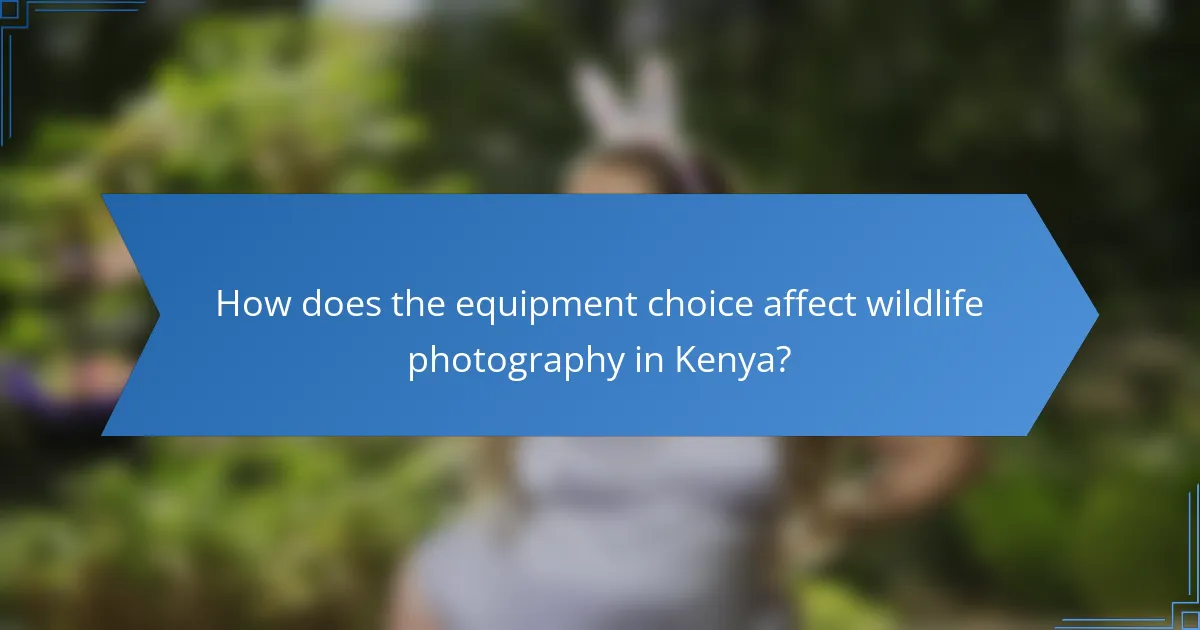
How does the equipment choice affect wildlife photography in Kenya?
The choice of equipment significantly impacts wildlife photography in Kenya by influencing image quality, accessibility, and versatility. High-quality lenses, such as telephoto lenses, allow for capturing distant wildlife without disturbing their natural behavior. Lightweight and durable gear is essential for navigating diverse terrains, ensuring photographers can adapt quickly to changing conditions. Additionally, the use of camera bodies with fast autofocus systems can enhance the chances of capturing action shots of elusive animals. Choosing the right equipment ultimately enhances the overall photography experience in Kenya’s unique landscapes.
Which camera settings are optimal for capturing wildlife in different conditions?
Optimal camera settings for wildlife photography in Kenya vary by conditions. Use a fast shutter speed (1/1000s or faster) to freeze motion, a wide aperture (f/2.8 to f/5.6) for shallow depth of field, and adjust ISO based on light (400-1600 in low light). In bright daylight, lower ISO (100-400) is ideal. For low light or dusk, increase ISO while balancing noise. Use continuous autofocus for moving subjects and consider burst mode for capturing action.
What type of lenses are best suited for wildlife photography?
Telephoto lenses are best suited for wildlife photography. They allow photographers to capture distant subjects with clarity and detail. A lens with a focal length of 300mm or longer is ideal for photographing animals in their natural habitats. For example, a 400mm lens provides excellent reach for capturing birds or large mammals without disturbing them. Additionally, lenses with image stabilization help reduce motion blur, which is crucial in dynamic wildlife settings.
How do accessories like tripods and camouflage gear improve results?
Accessories like tripods and camouflage gear significantly enhance wildlife photography results. Tripods provide stability, allowing for sharper images, especially in low light. Camouflage gear helps photographers blend into the environment, reducing the chances of startling wildlife.
Tripods allow for longer exposure times, crucial for capturing details in dynamic settings. They also facilitate shooting from various angles, improving composition. Camouflage gear enables closer proximity to animals, increasing the likelihood of capturing natural behaviors.
Using these accessories can lead to higher quality images and more successful wildlife encounters. Photographers can achieve better framing and focus, essential for stunning wildlife portraits.
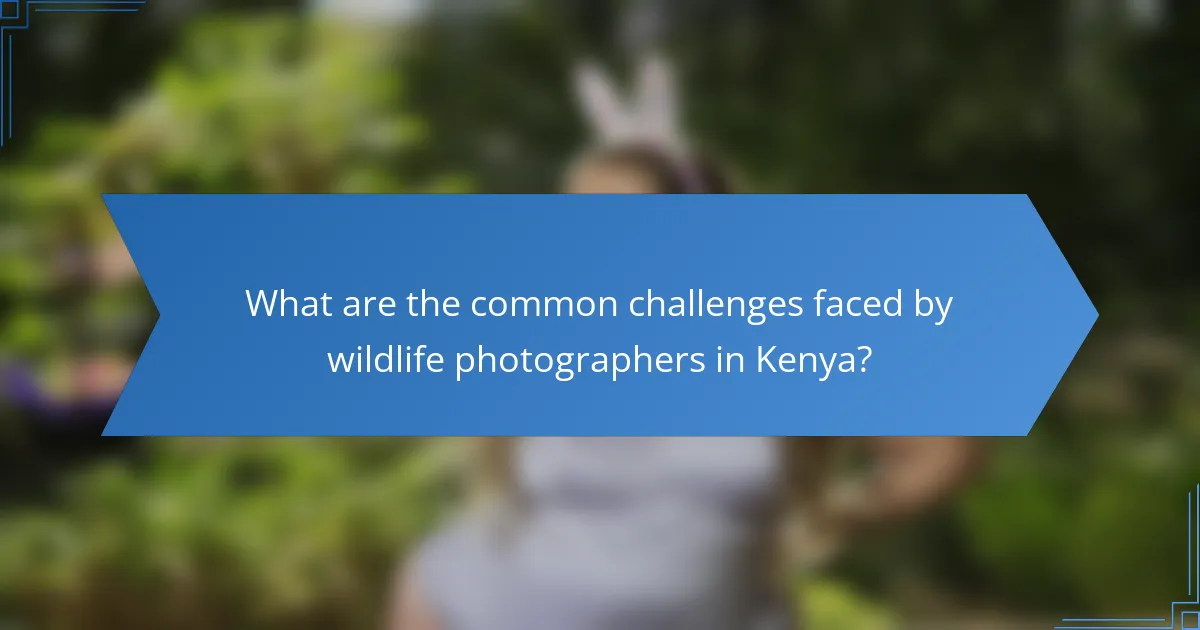
What are the common challenges faced by wildlife photographers in Kenya?
Wildlife photographers in Kenya face challenges such as unpredictable weather, difficult terrain, and limited access to remote locations. Additionally, ethical considerations regarding wildlife disturbance and preservation of habitats complicate their work. Competition for prime locations further intensifies the pressure on photographers.
How does weather impact wildlife photography opportunities?
Weather significantly influences wildlife photography opportunities in Kenya. Different weather conditions can enhance or hinder visibility and animal behavior.
For example, the rainy season creates lush landscapes and attracts diverse wildlife, offering excellent photo opportunities. Conversely, harsh sunlight can cause animals to seek shade, making them less visible.
Additionally, overcast days often provide softer light, reducing harsh shadows and enhancing image quality. Understanding seasonal weather patterns can help photographers plan their trips effectively.
In summary, adapting to weather conditions is essential for capturing stunning wildlife images in Kenya.
What strategies can be used to overcome wildlife tracking difficulties?
To overcome wildlife tracking difficulties in Kenya, utilize the following strategies.
1. Leverage technology such as GPS devices and mobile apps for real-time tracking.
2. Collaborate with local guides who have intimate knowledge of wildlife patterns.
3. Conduct thorough pre-trip research on species behavior and migration routes.
4. Practice patience and adaptability to changing environmental conditions.
5. Use camouflage and quiet equipment to avoid disturbing animals during observation.
How can photographers deal with the unpredictability of animal behavior?
Photographers can manage the unpredictability of animal behavior by adopting patience, understanding animal instincts, and utilizing proper techniques. Observing animals from a distance allows photographers to anticipate movements and capture candid moments. Knowledge of specific species’ behavior in Kenya enhances opportunities for successful wildlife photography. Ethical considerations, such as minimizing disturbance, further contribute to a more rewarding experience.
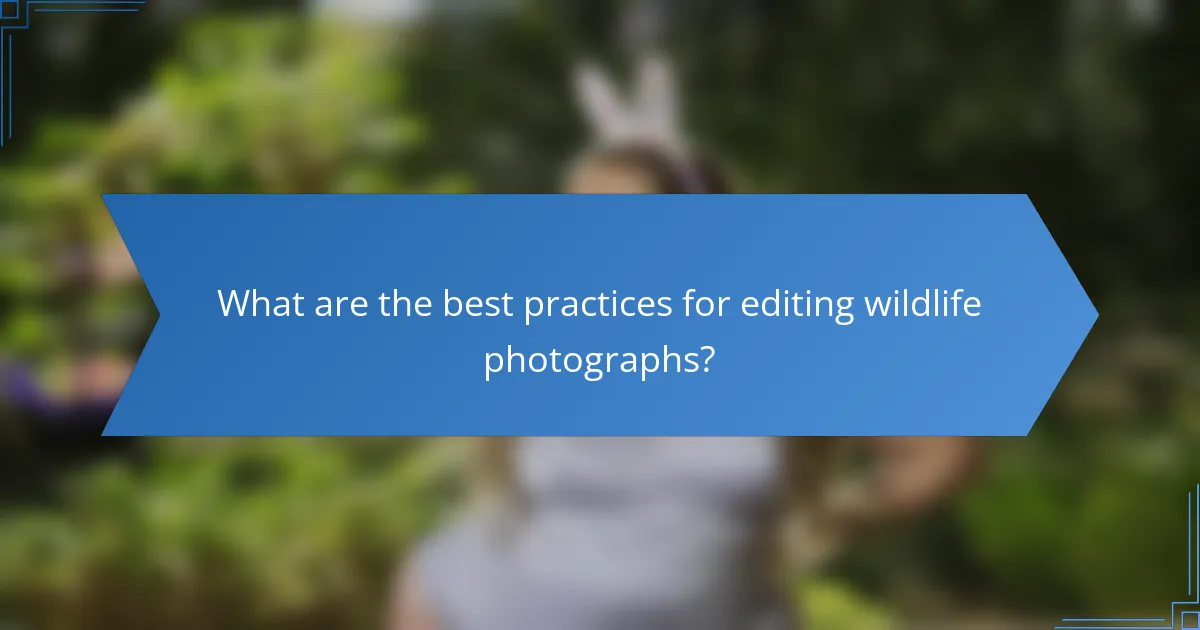
What are the best practices for editing wildlife photographs?
To edit wildlife photographs effectively, focus on enhancing natural colors and details while maintaining ethical standards. Use software to adjust exposure, contrast, and sharpness without altering the essence of the image. Prioritize minimal cropping to preserve the subject’s context, ensuring wildlife remains undisturbed.
How can post-processing enhance the storytelling aspect of wildlife images?
Post-processing enhances storytelling in wildlife images by refining visual elements and emphasizing emotional narratives. Techniques like color grading and cropping can highlight the essence of the subject, creating a more immersive experience. For instance, enhancing contrast can draw attention to an animal’s features, while softening backgrounds can evoke a sense of tranquility. Additionally, post-processing allows for the correction of lighting issues, ensuring that the mood aligns with the story being told. Ultimately, these enhancements can transform a simple photograph into a compelling narrative that resonates with viewers.
What ethical considerations should be taken into account during photo editing?
Ethical considerations in photo editing for wildlife photography include maintaining authenticity, avoiding manipulation, and respecting subjects. Photographers should ensure edits do not misrepresent the animal’s behavior or habitat. Transparency about editing practices fosters trust with audiences. Additionally, minimizing stress on wildlife during shoots is crucial to ethical practices.
Which software tools are recommended for wildlife photography editing?
Adobe Lightroom, Capture One, and Photoshop are recommended software tools for wildlife photography editing. These programs offer advanced features for color correction, noise reduction, and sharpening, essential for enhancing wildlife images. Adobe Lightroom is particularly favored for its user-friendly interface and powerful cataloging capabilities. Capture One provides exceptional color grading tools, while Photoshop excels in detailed retouching and compositing. Each tool supports RAW image formats, ensuring high-quality edits.
What common mistakes should photographers avoid in wildlife photography?
Photographers should avoid common mistakes like disturbing wildlife, neglecting ethical guidelines, and failing to prepare for variable conditions. Respecting animal behavior is crucial to capture authentic moments. In Kenya, understanding local species and habitats enhances success. Always prioritize safety and conservation.